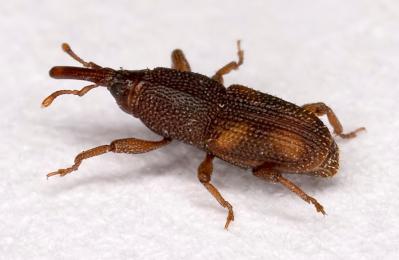All Pests
Pest Identification & Solutions
I have a problem with ...
Bird Mites
SOLUTIONS AVAILABLE: 17
Bird mites are not insects as some of the public may think as they have eight legs and two body parts. The most common mite associated with bird nests is the “Starling mite” or “Tropical fowl mite”
Subterranean Termites
SOLUTIONS AVAILABLE: 47
Members of the Coptotermes genus are easily distinguished from other termites when the soldier is poked or lightly squeezed, upon which a white milky liquid is secreted from a specially modified pore (fontanelle) in the front of the head as a defence mechanism
Drywood Termites
SOLUTIONS AVAILABLE: 9
Unlike other termites, drywood termites get their water from the timber they consume and therefore do not require contact with the soil. Because of this fact, their galleries are clean and free of soil. However there is one thing present that will give away that drywood termites caused the damage: the presence of dry, sesame seed-like frass (faeces) throughout the gallery system and on horizontal surfaces in close proximity to the infestation.
Warehouse Beetle
SOLUTIONS AVAILABLE: 5
Adult warehouse beetles are oval in shape, 1.8 to 3.0 mm long. They are light to dark brown in colour and covered with fine hairs. The elytra have various pale markings according to the species concerned.
Saw-toothed Grain Beetle
SOLUTIONS AVAILABLE: 5
Saw-toothed grain bettles are small, slender, flattened, brown beetles, 3 to 3.5 mm long. They are easily distinguished by the 6 saw-like "teeth" on each side of the thorax.
Rice Weevil
SOLUTIONS AVAILABLE: 3
Adult rice weevils are 2.5 – 3.5 mm long, somewhat smaller than granary weevil. It is reddish brown, with 4 faint reddish or yellowish spots on the elytra, round or irregularly shaped punctures on the pronotum and with the typical long, slender snout at the front of the head
Lesser Grain Borer
SOLUTIONS AVAILABLE: 0
Adult lesser grain borers are about 3 mm long, polished reddish brown or black and the head and thorax have a pitted appearance. Rhyzopertha dominica is almost cylindrical and the head cannot be seen from above. Although small, this insect has powerful jaws with which it can bore directly into wood and paper.
Indian Meal Moth/Pantry Moth
SOLUTIONS AVAILABLE: 16
Adult indian meal moths have a wingspread of about 20 mm. The wings are bi-coloured cream and the outer portion of the forewing is reddish brown, with a coppery lustre. The adults are often seen flying about in the home and have often been mistaken for clothes moths but the wing colour is very distinct from the uniform grey of the clothes moth's wings
Flour Beetles
SOLUTIONS AVAILABLE: 3
Flour bettles are small, reddish-brown beetles, 2.6 to 4.4mm in length. Flour beetles are extremely common stored product pests and are found in household pantries and commercial food manufacturers and distributors. They are pests of dried material of plant and animal origin but especially stored grains and grain products, peas, beans, shelled nuts, dried fruits, spices, chocolate, cayenne pepper and other materials
Drugstore Beetle
SOLUTIONS AVAILABLE: 3
Adult drugstore beetles are oval and globular in shape and 3.0 to 4.0 mm long. The colour is uniformly reddish to reddish brown. Very fine hairs are arranged in longitudinal rows on the elytra. The drugstore beetle can be distinguished from the cigarette beetle by the distinctly striate elytra, the 3 enlarged segments at the tips of the antennae and by the less hairy larva.
Cigarette Beetle
SOLUTIONS AVAILABLE: 5
Adult cigarette beetles are light brown, small, oval and about 3 mm long. The head and prothorax are bent downward so as to give the insect a strongly humped appearance. It has occasionally been confused with the drugstore beetle (Stegobium paniceum) but L. serricorne has serrate antennae and smooth elytra, whereas in S. paniceum the last 3 antennal segments are long and broad, forming a distinct "club” and the elytra are striate.
White-Tailed Spider
SOLUTIONS AVAILABLE: 16
White-tailed Spiders have a dark reddish to grey, cigar-shaped body and dark orange-brown banded legs. The grey dorsal abdomen bears two pairs of faint white spots (less distinct in adults) with a white spot at the tip; the male has a hard, narrow plate or scute on the front of the abdomen.












